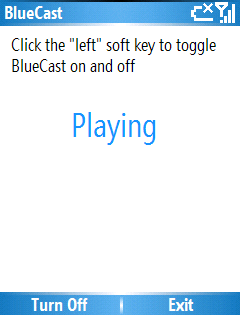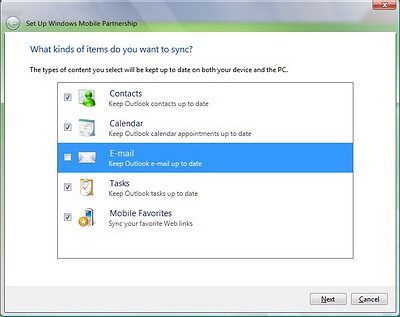July 17th, 2006
Jason Dunn
I have a real love/hate relationship with Bluetooth, because most of my experiences with it have involved frustrating configuration issues. I now have a Socket Bluetooth CompactFlash card in my laptop, and am using the Qtek 8500 Smartphone to get EDGE wireless data, which is handy to have when there’s no WiFi connection in sight. I haven’t dabbled much in Bluetooth audio, however, largely because I haven’t had any hands-on time with Bluetooth headphones and won’t plunk down the cash for headphones without hearing what they’re like (or at least reading a great review). If you’re more of a Bluetooth audio trailblazer than I am (and that’s not difficult to imagine, as you’ve read), then check out this new piece of software from SimpleSmartphone dubbed BlueCast:

“BlueCast streams all device sounds to your Bluetooth headset including your podcasts, music, TomTom sounds, GPS navigation commands, voice notes, game sounds, and more. Simplify your life and leverage your Bluetooth headset investment by purchasing BlueCast. BlueCast gives control to applications like the phone app when they ask, and take it back as soon as they are done. This allows for seamless listening all without wires. Yes, the days of having to untangle your headphone cords are done. Maximize your daily productivity and multi-task by purchasing BlueCast today.BlueCast was designed for Windows Mobile 5.0, however, it does work on some Windows Mobile 2003 devices.”
At the moment the software is $9.99. I think what appeals to me about this software is how simple it is - this is how I always wished Bluetooth would work.
July 12th, 2006
Jason Dunn
In the Windows Mobile world, there are two types of people: those that use a Pocket PC and a mobile phone, and those that use a single device that is their PDA and phone (either a Smartphone or a Pocket PC Phone Edition). There are people that feel passionately about the subject on either side of the fence: the one device people (converged) say it’s easier to carry one device that does it all. Less bulk, less hassle. The two device people tend to think that one “do it all” device has too many compromises, and a dedicated PDA with a big screen partnered with a mobile phone with great battery life will give them the best of both worlds.
This issue comes up just as strongly when it comes to digital media devices, whether they be digital audio players or full-blown portable media playback devices. For years, I used my Pocket PC as my only digital audio player. I loaded up big memory cards with music, connected my headphones, and enjoyed only carrying one device. I shunned the idea of using a dedicated music player, because it was easier for me to have a converged device. Then one day I was given a 4 GB Zen Micro player, and after using it, I became a two device guy. The single biggest reason? Battery life. I found that when I was using a single converged device, I was worried that listening to music for too long would result in a dead battery. And a dead battery on a device that is my phone and PDA is disastrous - I rely on my device heavily. So that resulted in me not listening to music on a plane trip for example. On the other hand, having a dedicated audio player let me listen to as much music as I wanted, and when the battery went dead, I lost nothing but the ability to listen to music. Earlier this year I picked up a Creative Zen Vision:M for exactly the same reason: even though the screen is bigger on my I-Mate Jasjar, and the video playback more impressive, with the Vision:M I can use it as much as I want and not care about the impact on my communications and organization.
However…
Last week I picked up a Qtek 8500 (a.k.a. HTC Star Trek) and I decided I’m going to try going back to the one device world. The Qtek 8500 is nice and small, and once Sandisk sends me one of their 1 GB microSD cards, I’ll load it up and use it as a music player. The Qtek 8500 has impressive battery life as a phone, so I’m hoping it will be equally impressive as a music player. I’ll let you know how things go!
July 5th, 2006
Jason Dunn

[click the image above for a high-res photo]
The Toshiba Gigabeat S is a second generation Portable Media Center device that’s the polar opposite of the LG PM70. Where the PM70 was a big-screen device aimed at delivering a great video-watching experience, the Gigabeat S is has it’s sights set right on the heart of the iPod (as in, a mostly audio-focused device), and if early reviews are any indication, it will deliver a haymaker punch. The iPod empire will not topple overnight, but if Toshiba’s Gigabeat S is any indication of what we have to look forward to, the future of PMCs is bright indeed.
At CES 2006, I had some hands-on time with a pre-production Gigabeat S, and I was quite impressed. The first thing that impressed me was the size - I had never seen Windows Mobile running on anything that small before (this was before the release of the HTC Star Trek). The 30 GB version of this device weighs a featherweight 4.8 ounces and measures 3.93 by 2.36 by 0.58 inches. It’s small. The 60 GB version is exactly the same size but weighs 5.3 ounces. Did you catch that? 60 freakin’ gigabytes! That might be old news to iPod owners, but it’s great news for PMC owners. In first generation PMCs, 20 GB was where storage topped out. The LG PM70, a video-focused unit (where storage is even more important), only comes in a 30 GB flavour. The Gigabeat S 60 GB offering is a different colour - jet black - and as you can tell, I’m excited about having 60 GB of storage. Unfortunately, that’s not quite enough space for me to carry 100% of my music collection (which stands at 67 GB) but it’s a heck of a lot better than 30 GB. (more…)
June 26th, 2006
Jason Dunn
In researching the reader Q&A from last week about playing full-screen video, I came across a handy Web page that is a good guide for decoding what audio and video formats are supported by each player. The table itself takes a bit of puzzling over if you’re not already familiar with the different audio and video formats, but if you know what you’re looking for, it’s a great tool. All in all, it still looks like TCPMP is the most flexible player out there in terms of being able to handle just about any file format.
June 23rd, 2006
Jason Dunn
Kris Kumar over at Smartphone Thoughts has put together a super-detailed screen-by-screen overview of the new Vista Windows Mobile Device Center. How detailed? We’re talkin’ five pages long, and 36 (!) screen shots covering every step in the process.

What I found quite interesting is the effort that has gone into creating a system by which content flows from the device to the computer. Previously, ActiveSync was 100% focused on getting media content from the PC to the device. If there was media on your Windows Mobile device (say, photos you had taken with it) and you wanted it put on your computer, you’d have to open up ActiveSync, click Explore, then drill down into the folder structure on the device to find the media. And it wasn’t always simple, because each OEM/developer would have different ideas about where the best place to put your media was. Microsoft has also added a step where you can specify the folder you want to put the imported photos in, or it can create a folder for you based on the date the images were imported (I think it should be the date the images were taken) and a custom tag that you can assign.
Overall, this looks like a good first step - but when you get right down to is, this is most of the same basic functionality we’ve had in ActiveSync for years (or less if you consider WiFi sync is still missing) with a candy-coated shell on top. I know that re-working the GUI and plugging it all into Vista takes time though, so I’m hoping that in future revisions we’ll see more in the way of new features. What kind of features would you like to see? Myself, I’d like to see more fine-tuned control over video importing (Windows Media Player 10 isn’t very flexible in this regard) and the ability to schedule polling of a network resource for conversion - I have Windows Media Center Edition 2005 installed on a PC different from the one that I use for day to day work and synching my Windows Mobile devices with. So that makes it difficult to have media ready to go, and in the right format, for when I need it.
Next Posts
Previous Posts


